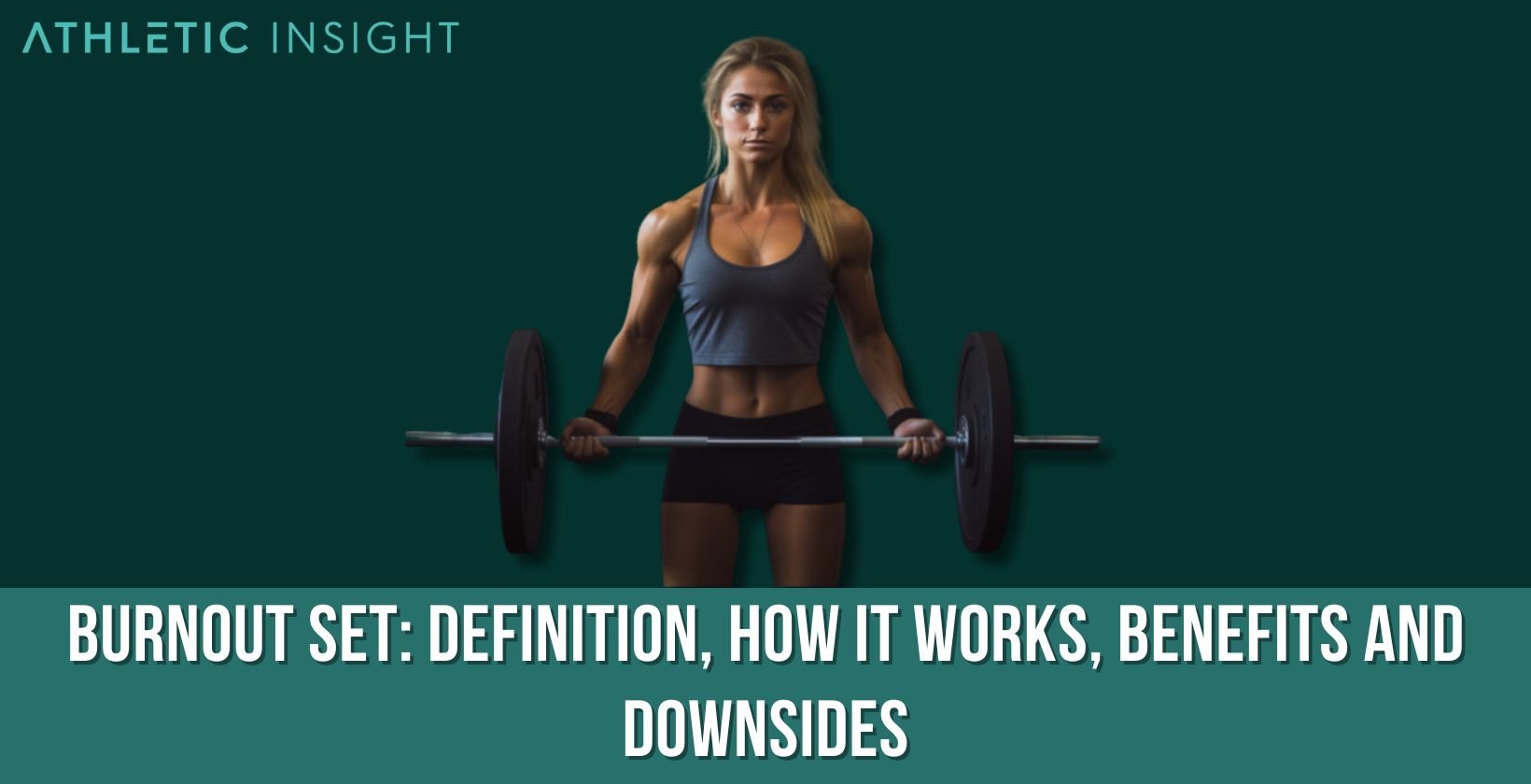A burnout set is a potent component of a well-rounded fitness regimen. As an advanced technique within the sphere of resistance training, it is strategically designed to push the body’s musculature to its absolute limit. This is accomplished by performing a set of a specific exercise until the targeted muscle group can no longer sustain the effort, a state referred to as ‘muscular failure’. The ultimate objective is to trigger an intense response in the muscles that stimulates growth, adaptation, and enhanced performance.
However, employing burnout sets within a workout routine is not without its complexities. Not only does it necessitate an unwavering level of mental resilience, but it also requires diligent attention to proper form, nutrition, and recovery to prevent potential injuries and ensure maximum benefit.
Understanding the operational mechanism, potential advantages, and downsides, along with the right strategies for optimization, is integral for anyone considering integrating burnout sets into their fitness regime. This article covers all these aspects to provide a comprehensive understanding of this powerful exercise technique.
What is a Burnout Set?
A burnout set, often synonymously referred to as a burnout workout, denotes a high-intensity exercise technique aimed at exhausting muscles to the point of failure. This is achieved by performing a maximum number of repetitions on a chosen exercise, using a lighter load, until the muscle group targeted is completely fatigued.

The science behind burnout sets is rather straightforward yet intriguing. The burnout workout aligns with the principle of muscle hypertrophy – the increase in muscle cell size. Burnout sets are intended to push the muscles beyond their comfort zone, thereby stimulating muscle fibers to adapt and grow stronger, providing an impetus for improved muscle endurance and hypertrophy.
How Does a Burnout Set Work?
The effectiveness of a burnout set lies in its systematic approach towards muscular exhaustion. Burnout sets are typically incorporated at the end of a workout, as a finale to the standard set-and-rep scheme. By doing so, it ensures the full utilization of muscle fibers, which may not have been adequately stimulated during the regular sets.
Firstly, the exerciser completes their routine workout, concentrating on specific muscle groups. Thereafter, a burnout set is executed using the same muscle groups with reduced weight but increased repetitions until the muscles can no longer perform the task. This further fatigues the muscles, forcing them to work harder and adapt to these intense conditions.
What Is the Importance of a Burnout Set for Your Fitness Routine?
Incorporating burnout sets into a fitness routine can offer substantial advantages. Primarily, it contributes to enhanced muscle growth and endurance by increasing the volume of your workout, meaning the total weight lifted. Greater volume is associated with improved muscle hypertrophy, as it places additional demand on your muscles, compelling them to grow.
Burnout sets can also augment metabolic stress, a factor contributing to muscle growth, by prolonging the time under tension for the muscles. This is the cumulative time a muscle spends contracting against resistance during a set. Increased time under tension can boost the release of growth factors, encouraging greater muscle hypertrophy and improved muscular endurance.
What Are the Best Strength Training Burnout Sets?
The effectiveness of burnout sets can be influenced by the chosen exercise. Some efficacious strength training burnout sets include bench press, squats, bicep curls and pull-ups.
- Bench Press: A staple in many strength training regimens, performing a burnout set on the bench press can stimulate significant pectoral and tricep muscle growth.
- Squats: A fantastic lower-body exercise, burnout sets of squats can promote hypertrophy in the quads, hamstrings, and glutes.
- Bicep Curls: Excellent for targeting the biceps specifically, performing a burnout set with this exercise can lead to impressive arm growth.
- Pull-Ups: A comprehensive upper body exercise, burnout sets of pull-ups can stimulate growth in the lats, biceps, and various other muscle groups.
What are the Benefits of Burnout Sets?
Burnout sets, when incorporated correctly, can offer numerous benefits such as enhanced muscular hypertrophy, improved muscular endurance, and greater metabolic stress.
- Enhanced Muscular Hypertrophy: By fatiguing the muscle completely, burnout sets can stimulate increased muscle growth.
- Improved Muscular Endurance: The high rep range associated with burnout sets can lead to improved muscular endurance, aiding performance in both strength and cardiovascular training.
- Greater Metabolic Stress: The increased time under tension during a burnout set leads to heightened metabolic stress, a contributing factor to muscle growth.
What are the Downsides of Burnout Sets?
Despite the numerous benefits, burnout sets do come with potential downsides such as increased risk of injury, overtraining, and not being suitable for beginners.
- Increased Risk of Injury: The extreme fatigue induced by burnout sets can lead to compromised form, increasing the risk of injury.
- Overtraining: Regularly incorporating burnout sets can lead to overtraining, potentially resulting in decreased performance and slowed recovery.
- Not Suitable for Beginners: Due to the intense nature of burnout sets, they may not be suitable for those new to exercise or those with certain health conditions.
What Should You Do Before Starting a Burnout Set Exercise?
To minimize the risk of injury and maximize effectiveness, a few precautions should be taken before performing a burnout set. Firstly, it is crucial to ensure proper form on all exercises to prevent unnecessary strain and injury. Secondly, a thorough warm-up should be performed to prepare the muscles for the intense work ahead. Finally, it is essential to listen to your body and avoid pushing too far past your comfort zone to a point where injury becomes likely.
What Are Examples Of Burnout Set Exercises for Shoulders?
There are several effective burnout set exercises for shoulders, these include the dumbbell shoulder press, lateral raises, and front raises. Ultimately, any shoulder exercise can be a burnout set.
- Dumbbell Shoulder Press: An excellent compound movement, this can stimulate growth in the deltoids and triceps.
- Lateral Raises: This isolation exercise can target the lateral deltoid, leading to increased shoulder width.
- Front Raises: Another isolation exercise, this targets the anterior deltoid, contributing to overall shoulder development.
What Are Examples of Burnout Set Exercises for Legs?
Some potent burnout set exercises for legs include the leg press, calf raises and lunges. A leg exercise is statistically the most mentally and physically exhausting muscle group to train, especially when it comes to burnout sets.
- Leg Press: A compound exercise, the leg press can promote growth in the quads, hamstrings, and glutes.
- Calf Raises: An isolation exercise, this can lead to increased calf size and definition.
- Lunges: Another compound exercise, lunges can stimulate growth in the quads, hamstrings, and glutes.
What Should You Not Do on Burnout Set Exercises?
When performing burnout set exercises, there are a few key points to absolutely avoid such as sacrificing form, overdoing the exercise and neglecting rest. If you do not avoid these three major risks, it may lead to injury or worse.
- Sacrificing Form: The intense nature of burnout sets should not be an excuse for poor form, as this can lead to injury.
- Overdoing It: While pushing to the point of muscle failure is the goal, it’s crucial to listen to your body and avoid pushing to the point of injury.
- Neglecting Rest: Recovery is just as important as the workout itself. Ensure you give your muscles adequate time to recover before performing another burnout set.
What Is the Nutritional Support for Burnout Set Training?
Nutrition plays a pivotal role in supporting burnout set training. Each of the three macronutrients (protein, carbohydrates, fats) are essential for training, especially when performing burnout sets.
- Protein: Crucial for muscle repair and growth, aim for around 1.6-2.2 grams of protein per kilogram of body weight daily.
- Carbohydrates: Provide the energy required for intense workouts. Aim for a diet comprising around 45-65% carbohydrates.
- Healthy Fats: Important for overall health and can also be used for energy. Aim for a diet comprising around 20-35% fats.
How to Avoid Injury During Burnout Set Training?
There are a few key strategies to minimize the risk of injury during burnout set training. This includes prioritizing proper form, warming up and listening to your body.
- Prioritize Proper Form: Ensuring proper technique on all exercises is crucial to prevent injury.
- Warm-Up: Preparing the muscles with a thorough warm-up can minimize the risk of strains and sprains.
- Listen to Your Body: Be mindful of your body’s signals. If a particular movement causes pain, it’s important to stop immediately and seek medical advice if necessary.
Is a Burnout Set Work out Difficult?
Yes, burnout set workouts are difficult and inherently challenging. The very nature of burnout sets, pushing muscles to the point of failure, makes them a tough addition to any workout regimen. However, with the right preparation and approach, they can be effectively incorporated into most fitness routines to enhance muscle growth and endurance.
Should You Keep Hydrated when Performing Burnout Set Exercises?
Yes, hydration is of paramount importance when performing burnout set exercises. Intense workouts can lead to significant fluid loss through sweat, which can compromise performance and recovery if not replaced. Therefore, maintaining adequate hydration before, during, and after exercise is crucial.
What Is the Difference Between Burnout Sets from Supersets?
Burnout sets and supersets are both advanced training techniques, but they differ in their structure and objectives. A burnout set involves performing an exercise to the point of muscular failure, thereby stimulating maximal muscle growth and endurance.
In contrast, a superset involves performing two exercises back-to-back with no rest in between, typically targeting either the same muscle group (for increased intensity) or two different muscle groups (for efficiency and time management). While both techniques aim to enhance workout intensity and promote muscle growth, their applications and the exact physiological responses they elicit differ.



